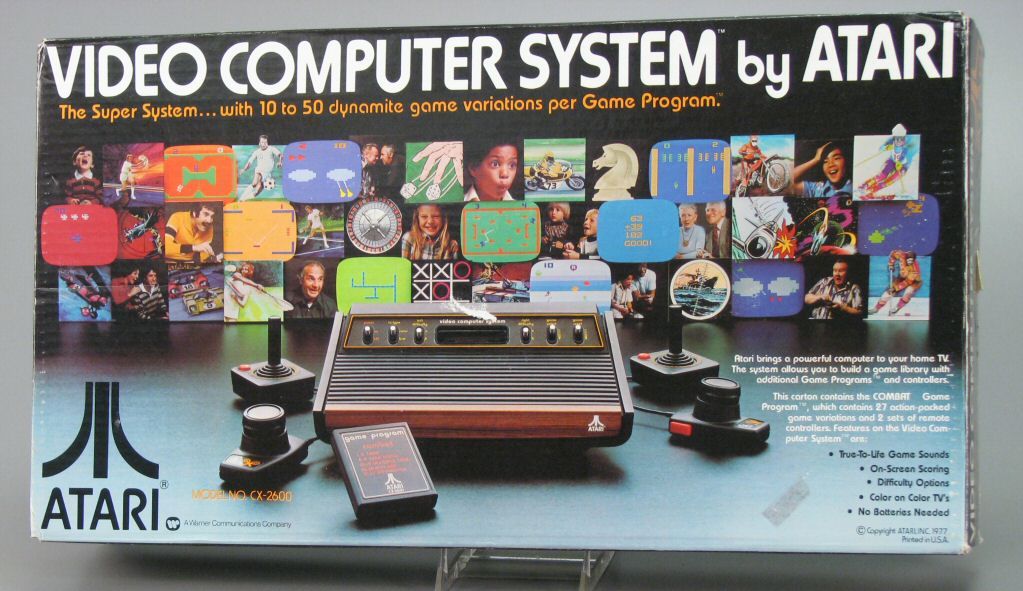
Retro Computer Chess part 4: Atari Video Chess (1979)

After Microchess, one of the first chess games to hit homes was Atari Video Chess for the Atari VCS 2600 console. Home consoles up to that time were specialised affairs that could only play one specific game, such as Pong. But the 2600 allowed any number of games to released as interchangable cartridges. And the first version of the box the console came in emphasized this by displaying a number of exiting activities you could simulate on your home video console system. These activities supposedly included skiing, car racing, sea battles, gambling and... chess.

However, as urban legend has it, the latter turned out to cause some headaches at Atari. There was some internal dissent as to wether the machine would ever be capable of actually playing a game of chess. Apparently a man from Florida sued Atari over the boxing displaying a chessman (a white knight), but not being able to present a playable game of chess. Later versions of the box art were modified so the white knight was replaced with another picture.
Wether this story is true or not, creating a chess game became a priority at casa Atari. One guy was able to create the algorithm to calculate the chess moves, but he was unable to actually render a readable board on the screen. The 2600 could only present a very limited number of objects on the screen, so drawing 64 squares with 32 chess men on them turned out to be a problem. But another programmer came up with a clever hack: Using a technique dubbed "ventian blinds", only alternating lines of each piece was drawn, thus halving the number of objects being drawn each line. The result is that all pieces have noticable scanlines across them, and they are not exactly pretty, but it is possible to make out the board and all the individual pieces on the screen. Below is an example showing the white queen and king in detail. Notice how the lines representing the king are shifted one line lower than the lines representing the queen.

The game was developed by Larry Wagner (AI) and Bob Whitehead (UI) and finally released in 1979.

Apart from the board, there is not much going on on the screen. There is a single number indicating which level the computer is playing at, and a cursor indicating which square is selected for a move. That's it.

When the computer is calculating a move, the screen even goes completely blank, only flashing alternating colours to indicate activity. Apparently this was a necessity to preserve processor time needed for calculating moves.
The game has 8 different levels of difficulty; 1 through 7 spends progressively more time for each move. Level 1 takes roughly 15 seconds. Levels 4 and 5 is supposed to take 2 minuts and 45 seconds and 3 minutes and 15 seconds respectively, making these levels the most relevant for tournament level play. Level 7 is supposed to take a whopping 10 hours per move. Level 8 is a beginners level that moves in 10 seconds and makes deliberate mistakes.
Moves are made by using a joystick to move the cursor on the screen. Levels are changed using switches on the console. There is also a black-and-white mode, which was not only a necessity at the time since many people did not have a colour TV, but IMO makes the game more playable on colour monitors since the palette used makes it a bit hard to distinguish the colours of the pieces.
Castling and en passant is supported and played. Pawns are by default promoted to queens, but if you wish to underpromote you are free to use the setup feature of the game to replace the queen with any piece you wish.
It has a very limited book that will serve it for only a couple of moves before it needs to start thinking.
The game has some entries at archive.org, but none of them appear to be playable. I have however been able to acquire the ROM and play it locally using the Stella emulator on my PC, or one of the many 2600 emulators available for Android. Some of these emulators also offer a speedup option, which is useful if you wish to test the game at higher levels. Be warned, though, that the cursor control is somewhat clunky and unresponsive, so some patience will be required if you wish to test the game yourself.
The strenght is not half bad all things considered, and it certainly seems to be somewhat stronger than Microchess, but maybe not by much. But any decent chess player should be fully capable of beating this game across all levels.
A couple of sample games. Here's one of me beating the game at level 5:
Here the game takes it's frustration out on Microchess. Not a fantastic game by any measure. If anything, the endgame highlights some of the limitations of the chess games of the time.
Finally, here's a video showing Atari Video Chess in action:
